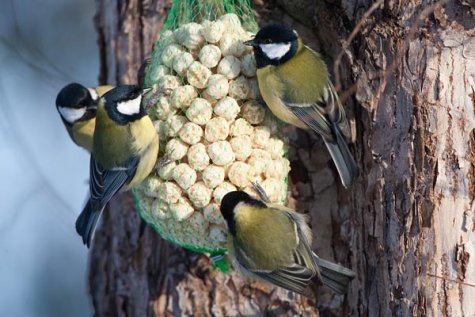Winter garden bird watch results
Photo: Arne Ader
Translation: Liis
Great tits
The Winter garden bird watch arranged by the Estonian Ornithological Society on January 26th and 27th offered nice surprises as regards participants as well as birds.
The number of watchers and observation points at the watch, that took place for the fourth year, had more than doubled compared to 2010. Compared to the previous year participants increased by one fourth.
At the observation points significantly more birds were seen compared to the previous year, and the variation in species increased too. 2501 bird friends sent their observations, from 1817 locations all over Estonia; altogether 65 266 birds were observed, of 61 species.
The average number of birds at one observation site (36) was larger by 1/8 compared to last year, the typical number of birds in one place (15) was higher by 1/4. One reason for these changes was certainly the winter without major frosts and with lower than average snow cover which was favourable enough for birds. Evidently the results were influenced as well by the prevalent weather on the observation day, that was windy at times but in general better than at some of the previous garden bird watches.
The most numerous species for the fourth year in row was the great tit that occurred at over 96% of the observation points and accounted for about a quarter of the total number of birds. The second place was again achieved by the greenfinch, third was the tree sparrow. For the majority of species no significant changes occurred in the numbers and observation frequencies; the species with the largest increases were the invasion birds jay and great spotted woodpecker. The species diversity increased compared to last year by seven species, mainly due to rarely seen species. Thus 12 middle spotted woodpeckers, eight gray shrikes, four green woodpeckers, two dippers, one wren and characteristically for this winter, also one pine grosbeak were seen in the observation places.
Among birds of prey the observation places were visited, outside the usual sparrowhawks (49 specimens), goshawks (13) and buzzards (6), also in 9 places by the pygmy owl, and in one place a Ural owl and a white-tailed eagle were seen.
There were observation places in 207 municipalities this year, 12 more than last year. The largest number of observation places was as expected in Tallinn, followed by the city of Tartu, Viimsi parish, Harku parish, Pärnu city and Rae parish. In the total number of birds the first place also belonged to Tallinn, with the cities of Tartu and Pärnu following.
The theme query in this year’s garden bird watch was the occurrence and abundance changes for the bird of the year, the partridge. This winter almost 10% of those submitting replies had seen partridges at their observation points, the largest group seen had nearly 30 birds. More than 50% of those replying believed that the number of partridges had declined strongly, nearly 30% estimated the decline to be moderate, an increase had only been noted by 4% of the participants.
The Estonian Ornithological Society thanks all who participated in the Garden bird watch.
A more comprehensive summary can be read at www.eoy.ee/talv
The next Winter garden bird watch takes place on January 25th -26th, 2014.
Estonian Ornithological Society
Additional information:
Aarne Tuule
Co-ordinator of the Winter garden bird watch
Estonian Ornithological Society
GSM 58002869









